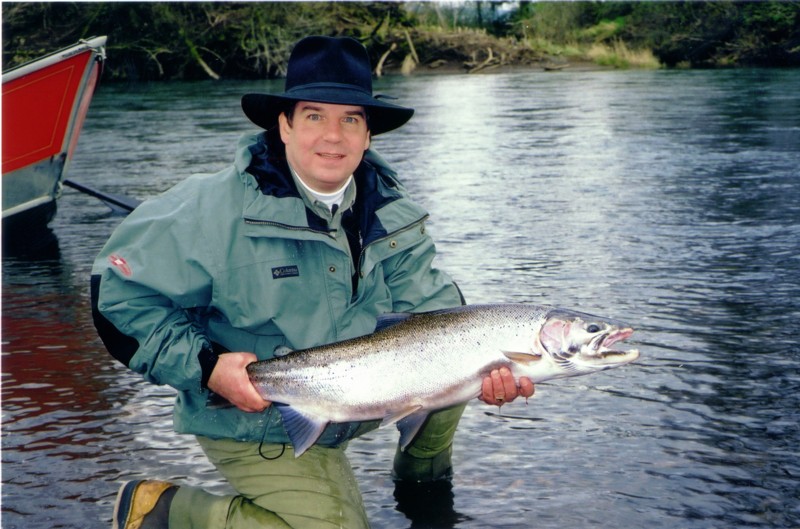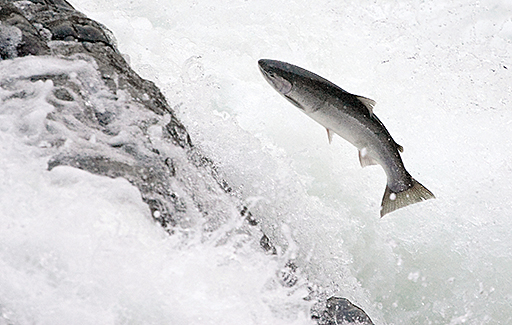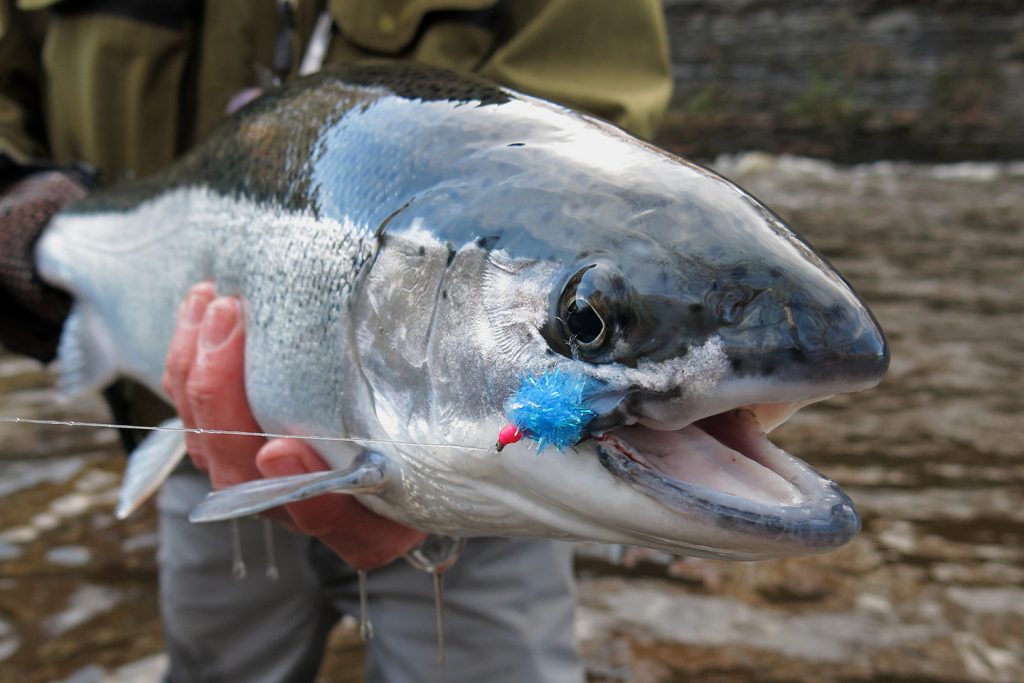100 years ago Zane Grey discovered Oregon and steelhead. Starting on the Rogue he cast flies and caught steelhead, marveling at the fight and beauty of every one of them. Grey, a prolific and celebrated outdoor writer and novelist, traveled the world in search of fish, wildlife and things to write about and enjoy. Oregon and the northwest proved to be strong draws that brought him back regularly to sample the variety, tenacity, splendor and solitude.
“The run of a bonefish”, he wrote, “after he is hooked, is certainly great, but the strike of a steelhead is all run. You have no choice but to run yourself.”
The northwest is blessed with so much great fishing. Chinook salmon, redside rainbow trout, coho, sturgeon, bass, halibut, walleye and tuna are all worthy targets but steelhead stand alone. There’s a certain reverence associated with steelhead. “Grey ghosts” as they’re sometimes called.
In the northwest we harvest wild trout and salmon but we don’t harvest wild steelhead, even when the science says we can. There’s no right or wrong to it, steelhead are just held to a different priority and value. They are special and the way we view and treat them reflects that sentiment.
A single 10 pound steelhead can spell the difference between a good season and a great one. Honestly, not catching a fish doesn’t mean you were unsuccessful. You got out there, plied the water, enjoyed the outdoors and maybe the company of a friend, sibling, child or spouse…that’s a win! That’s the thing about steelheading, catching is wonderful and some will catch several in a season, but just being out there is a singularly special experience. And when you do connect and if you do land your fish it will likely be an event you replay in your mind over-and-over. There are few other fish that have this kind of pull.
December begins “steelhead season”. As our hemisphere captures less sunlight and temperatures plummet, winter steelhead lumber into their native streams and methodically plod upriver imprinted by the taste of their natal water.
They’ve come a long way.
Their pelagic journey back to the states occupies thousands of miles. It is there they roamed and fed in open water. Exposed. Vulnerable. Alone.
It’s been a couple years since they’ve been home and now there, the water is fresh and cold. In some streams snow lines the banks and the trees and canopies are dark, nearly black, hanging heavy and leafless.
Let there be no illusions, winter steelhead fishing can be downright brutal. And even though the chill can be stinging and wind numbing the rewards are indelible, sometimes firing lifetime memories.
It’s really the whole steelheading thing that’s fulfilling.

Their pelagic journey back to the states occupies thousands of miles. It is there they roamed and fed in open water. Exposed. Vulnerable. Alone.
It’s been a couple years since they’ve been home and now there, the water is fresh and cold. In some streams snow lines the banks and the trees and canopies are dark, nearly black, hanging heavy and leafless.
Let there be no illusions, winter steelhead fishing can be downright brutal. And even though the chill can be stinging and wind numbing the rewards are indelible, sometimes firing lifetime memories.
It’s really the whole steelheading thing that’s fulfilling.

It starts with getting a rod or two or three ready. Sorting and organizing jigs, spinners, beads, spoons, a collection of Corkies, Spin-N-Glo’s and maybe a few vintage Okie Drifters just so you feel like you have everything. With each category of gear there is the anticipation of using it.
There are purists. “I’m a spinner fisherman”, “Nothing but flies for me”, “Just spey rods here”, “Me, I exclusively drift fish”, “Strictly bobber and jigs..”, “Never bait”, “Only beads”, and the list goes on. Some prefer to float the streams they fish, others power up and down them. There are folks who free-drift, anglers that bobber-dog, boaters who backtroll plugs and plenty who wade and cast. That’s the beauty of steelheading there’s something for everyone.
Then there’s where and when.
There are still early traditional December steelhead streams in the Northwest.
“Traditional” steelhead streams start producing fish in December with fish showing clear into April. Wild steelhead, the holy grail of the species, cleverly pace themselves trickling in over months. It’s probably Mother Nature’s way of protecting a particular year-class in the event of some catastrophic environmental event either in the ocean or in the river. They trickle in and out.
Hatchery steelhead generally show in mobs. They run hot-and-heavy for a few weeks and then they’re done. Gone as quickly as they showed. That’s been one of the many knocks on hatchery-reared steelhead and has inspired the need to try some other approaches…like broodstock programs. “Broodstock” are wild steelhead that have been caught, spawned in a hatchery and then released back to the river to outmigrate to the ocean and return in a year or two to do it all over again. These programs are closely monitored and tightly regulated but have proved successful with higher return rates and longer run timing than conventional hatchery stocks.
Unlike salmon that always die after spawning, steelhead can make multiple spawning runs in and out of the ocean over several years. A recent scale sample from a Idaho-reared summer steelhead, told quite a story. First, age doesn’t seem to be a determinate of size where steelhead are concerned. This fish was 8 years old and only about 25” long. Her epic journey in and out of the Columbia had covered thousands of miles, scientists surmised about 4,000 miles, made 32 successful dam passages, dug 3 redds and produced about 9,000 eggs. She’d had quite a life and one a salmon will never know.
Then there’s the process of steelheading.

There’s a certain magic in standing on a river bank and making a long cast into the river. Whether it’s going old-school with a drift rig and feeling the telltale tap of the bottom or watching a bobber and jig drifting along a defined river seam, it’s a mesmerizing, satisfying experience when everything goes right.
With steelhead you want to have cat-like reflexes. The moment that bobber takes a dive or that tap turns into a pull, it’s game-on. Often times easier said than done, but that’s the goal…cat-like.
It’s all a part of that steelheading thing. Just like getting the gear ready, doing the homework, finding the stream, getting everything organized, double-checking to make sure it’s all there and finally getting to the stream, the anticipation and then the mechanics of steelheading are all integral parts of the steelheading experience.
Steelhead have already been caught. It’s December so it’s expected. Not many but steelhead nonetheless. The North Fork of the Nehalem along with the Klatskanine, Big Creek, Gnat Creek and Necanicum River are all good December prospects. All are located in the Northwest corner of Oregon. Go east to the Grande Ronde and you’ll find plenty of hatchery fish there too in December. It’s one of several rivers to the east with fish to catch.
January’s always been a focal month for steelhead. Nothing says “winter steelhead” quite like the chilly month of January. Dozens of rivers become great options for steelhead…even some creeks too.
February’s another good steelheading month, so’s March. Brood stock steelhead programs on a number of northwest rivers have made February, March and even April exceptional months for steelhead fishing and catching.
For the more adventurous steelheaders, try your hand at a creek. Tributaries of the big name rivers are great escapes for steelhead looking for quiet spawning water. Catching a steelhead in a small stream is one of the most rewarding and challenging experiences in fishing. It is. If you have some time and the inclination to explore you may be rewarded. Read the regs before you do to make sure you can.
Then there are those special waters, of which there are less. Shrouded in old forests and protected as catch-and-release or fly-only, some of them, like the North Fork of the Umpqua River have come on strong in the 21st century. Its holy water and a place Zane Grey found peace and stories and steelhead he caught on a fly.
COVID has taken so much from us this year but the one thing it’s given us is an opportunity to connect or reconnect with these special places and fish. These streams, especially the remote ones, keep us distanced, safe and engaged in a wonderful way. And steelhead prove to be the ultimate pay-off in all this. They are still remarkably special, available, accessible and relevant. Enjoy!